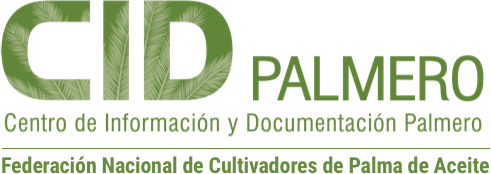ARTIFICIAL POLLINATION: ¿NAA IN LIQUID SUSPENSION OR NAA IN SOLID MIXTURE?

Author
García P.,, Alejandra M.
Ibagué R.,, Didier F.
Munévar M.,, Daniel E.
Hernández H.,, Juan S.
Mosquera M.,, Mauricio
Estadisticas
Publicación:
Revista Palmas; Vol. 41 Núm. 4; 15-26
0121-2923
Revista Palmas; Vol. 41 Núm. 4; 15-26
0121-2923
Abstract
Assisted pollination with E. guineensis pollen during the stage of anthesis is needed in Elaeis oleifera x Elaeis guineensis crops, otherwise natural pollination would not be sufficient to allow for proper fresh fruit bunch (FFB) formation. It is unlikely that without assisted pollination one may have a profitable oil palm operation (i.e. cultivos OxG). An alternative to assisted pollination is the artificial pollination, it was released by Cenipalma in 2018. Artificial pollination consists in applying nafthalen acetic acid (NAA) to female inflorescences in order to estimulate fruit formation. It can be performed during the stage of anthesis, 7 days after anthesis(dda) and 14 dda and, it has proven to yield better FFB conformation and to increasing palm oil content per FFB. Even though, Cenipalma released a method in which NAA was applied by means of a liquid suspension, growers tried with a solid mix (NAA+talc) arguing that the solid presentation is easier to handle at a field level. La polinización asistida con polen de E. guineensis durante la etapa de la antesis es necesaria en los cultivos de Elaeis oleiferaxElaeis guineensis, de lo contrario la polinización natural no sería suficiente para permitir la formación adecuada de racimos de fruta fresca(FFB).Es poco probable que sin la polinización asistida se pueda tener una operación rentable de palma de aceite(i.e. cultivos OxG).Una alternativa a la polinización asistida es la polinización artificial.La polinización artificial consiste en aplicar ácido naftalenacético(ANA)a las inflorescencias femeninas con el fin de estimular la formación de frutos.Se puede realizar durante la etapa de la antesis,7 días después de la antesis(dda) y 14dda y ha demostrado producir una mejor conformación FFB y aumentar el contenido de aceite de palma por FFB. A pesar de que Cenipalma lanzó un método en el que ANA se aplica en suspensión líquida,los cultivadores probaron con una mezcla sólida(ANA+talco)argumentando que la presentación sólida es más fácil de manejar a nivel de campo.
Assisted pollination with E. guineensis pollen during the stage of anthesis is needed in Elaeis oleifera x Elaeis guineensis crops, otherwise natural pollination would not be sufficient to allow for proper fresh fruit bunch (FFB) formation. It is unlikely that without assisted pollination one may have a profitable oil palm operation (i.e. cultivos OxG). An alternative to assisted pollination is the artificial pollination, it was released by Cenipalma in 2018. Artificial pollination consists in applying nafthalen acetic acid (NAA) to female inflorescences in order to estimulate fruit formation. It can be performed during the stage of anthesis, 7 days after anthesis(dda) and 14 dda and, it has proven to yield better FFB conformation and to increasing palm oil content per FFB. Even though, Cenipalma released a method in which NAA was applied by means of a liquid suspension, growers tried with a solid mix (NAA+talc) arguing that the solid presentation is easier to handle at a field level.
Palabras clave:
Assisted pollination, labor yield, Elaeis oleifera x Elaeis guineensis (OxG).
Polinización artificial
Elaeis oleifera x Elaeis guineensis (OxG)
Rendimiento
Mano de obra
Assisted pollination, labor yield, Elaeis oleifera x Elaeis guineensis (OxG).
Polinización artificial
Elaeis oleifera x Elaeis guineensis (OxG)
Rendimiento
Mano de obra


